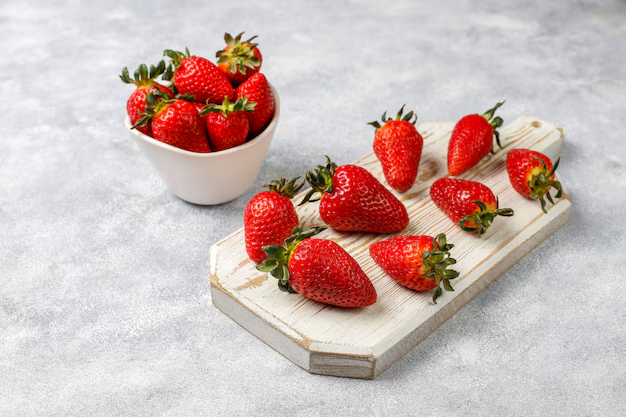Maximizing the Freshness of Your Strawberries: A Comprehensive Guide to Refrigerator Storage
Ah, strawberries! These juicy red gems are a favorite fruit for many, bursting with flavor and nutritional benefits. But if you're like most people, you've probably found yourself wondering how to keep your strawberries fresh in the refrigerator for as long as possible. Proper storage is key to enjoying this beloved fruit at its peak, so let's explore the best practices for keeping strawberries fresh in your fridge.
🍓 The Lifespan of Refrigerated Strawberries
How long strawberries stay fresh in the refrigerator depends on several factors, including their initial freshness, the storage methods used, and the conditions within your fridge. Under optimal circumstances, fresh strawberries can last up to a week in the refrigerator. However, several key steps can enhance or reduce this shelf life.
Initial Freshness
The fresher the strawberries when you purchase them, the longer they will last in your refrigerator. Look for strawberries that are firm, vibrant in color, and free from mold or soft spots. The greener the tops, the fresher the strawberries likely are.
Ideal Storage Conditions
Temperature and humidity are crucial for maintaining strawberry freshness. Keeping strawberries in an environment that's too damp or too dry can speed up spoilage. Generally, a balance of cool temperatures and moderate humidity works best.
Tip: Keep your fridge set between 32°F and 40°F with a relative humidity level of around 90%.
🚿 Preparing Strawberries for Storage
Before you tuck your strawberries into the fridge, it's essential to set the stage for optimal storage.
Washing and Drying
While it might be tempting to wash all your strawberries when you first get home, it's better to wait until just before consuming them. Moisture can lead to mold growth, so the less damp your strawberries are before storage, the better.
If you've already washed them, be sure to dry them thoroughly using paper towels. If possible, use a salad spinner to remove excess moisture.
Storage Containers: What Works Best?
The container you choose for storing strawberries in the fridge makes a difference. Opt for:
- Vented containers: These allow for air circulation, preventing too much moisture from building up.
- Paper towel lining: This helps absorb any moisture, keeping your strawberries dry.
- Original store packaging: If your strawberries came in a perforated container, this can also be effective as it allows for air circulation.
Avoid airtight containers, as they can trap moisture.
📦 Arranging Strawberries in the Fridge
When it comes to arranging strawberries, consider spacing. Overcrowding can damage the berries, leading to quicker spoilage. If you have a large quantity, spread them out across multiple layers with paper towels in between.
Place your strawberries in a section of the fridge where they won't be squashed, ideally in a designated fruit and vegetable drawer.
Identifying Signs of Spoilage 🕵️♀️
Keeping an eye on your strawberries for any signs of spoilage is crucial. Here’s what to look out for:
- Mold: White or greenish mold is a clear sign that it's time to discard the affected berries.
- Soft spots: While some softening can occur naturally, extensive soft spots indicate deterioration.
- Discoloration: Strawberries turning dark or losing their color may not be safe to eat.
If only a few strawberries show signs of spoilage, remove them immediately to prevent the spread to other berries.
Related Storage Tips: Beyond Strawberries
Understanding how to store strawberries can translate to other fruits and vegetables. Here are a few generalized tips for extending the shelf life of your produce:
🥦 Vegetables
- Leafy greens: Keep them in plastic bags with some air and a paper towel to absorb excess moisture.
- Root vegetables: Store them in a cool, dark place, separate from fruits that produce ethylene gas.
🍎 Other Fruits
- Berries (raspberries, blackberries): Treat similar to strawberries – unwashed, in ventilated containers.
- Apples: Store in the crisper drawer of your fridge; they produce ethylene gas that speeds up the ripening of other fruits.
📝 Summary: Extending Strawberry Freshness
Here's a quick summary to help you keep those strawberries fresh and delicious:
- Choose fresh strawberries: Firm, vibrant, and free from blemishes.
- Temperature control: Maintain fridge settings at 32°F to 40°F with around 90% humidity.
- Wash wisely: Only wash when ready to eat; dry thoroughly if washing beforehand.
- Use proper containers: Vented or original packaging with paper towels for moisture control.
- Check regularly: Remove any spoiled strawberries promptly to preserve the rest.
Keeping Strawberries Fresh: Bringing It All Together
Strawberry storage might seem straightforward, but understanding the nuances of humidity, ventilation, and temperature is key. By adhering to the practices outlined, you can ensure your strawberries remain delectable and fresh, minimizing waste and enhancing your eating experience. While the fridge might hold your strawberries for about a week under ideal conditions, these steps can help you maximize their lifespan and flavor. Enjoy your strawberries with peace of mind, knowing they are stored in the best way possible. 🍓
